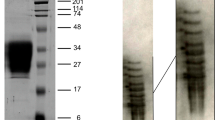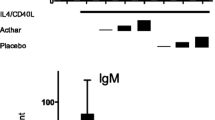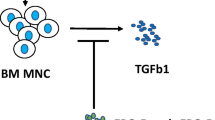Abstract
We have described previously the properties of two mutant ovine growth hormone receptor extracellular domain (oGHR-ECD) proteins which were created by substituting sequences from the rat GHR at two different locations within the framework of the oGHR-ECD. The first mutation occurred at a region close to the N-terminus of oGHR-ECD between residues Thr 28 and Leu34 and created the protein T28E/N29S/N33K/L34P-oGHR-ECD, where the ovine specific residues T, N, N and L are replaced by their equivalent residues E, S, K and P from the rat protein. This site lies N-terminal to the first element of β-strand structure in the GHR-ECD and we designated this protein as Site-A mutant. The second mutation was made between residues Ser121 and Asp 124 of oGHR-ECD to produce the protein S121T/E123D/D124E-oGHR-ECD where ovine specific residues are again replaced with the equivalent residues from the rat GHR-ECD. This region lies in a loop structure which joins the two β-barrel domains of the GHR-ECD. This protein is designated as Site-B mutant. A subsequent analysis confirmed the N-terminal region between residues 28–34 of oGHR-ECD as an important epitope defined by antiserum raised to oGHR-ECD. Also of interest was the finding that mutation at both Sites A and B in oGHR-ECD compromised the affinity of the protein for bovine GH (50-fold for Site-A and 4-fold for Site-B). A comparison of the affinity of wild type oGHR for the highly homologous bovine GH with its affinity for rat GH indicated a 10-fold higher affinity for the ruminant GH than for rat GH. Mutation at Site-A of oGHR-ECD reduced the affinity for rat GH a further 3-fold. However, mutation at Site-B of oGHR-ECD increased the affinity for rat GH 2–3 fold. This indicated that the substitution of rat GHR residues for ovine GHR residues in this part of the protein had a beneficial effect in relation to affinity for rat GH and that this region of the GHR-ECD may contain important specificity determinants. In order to test whether these observed differences in affinity for bovine and rat GH affinities have any biological relevance, we have produced the same ovine → rat mutations in the context of the full length ovine GHR. Transfection of the cDNAs encoding the wt or mutant GHRs into the mouse myeloid pre-B cell line FDC-P1 to create stably transfected clonal lines, has allowed an examination of the relative activities of ovine and rat GH, using a robust and high throughput bio-assay based on the reduction of a cell permeable tetrazolium salt. In the current manuscript, we report that the decrease in binding affinity previously reported for Site-A and Site-B mutant oGHR extracellular domain proteins is not reflected in compromised biological activities when the same mutations are expressed in the context of the full length oGHR protein. We discuss these findings in the context of the relationships between affinity and activity at the GHR.
Similar content being viewed by others
References
Clark RG, Robinson IC: Up and down the growth hormone cascade. Cytokine Growth Factor Rev 7: 65–80, 1996
Wells JA: Binding in the growth hormone receptor complex. Proc Natl Acad Sci USA 93: 1–6, 1996
Argetsinger LS, Campbell GS, Yang X, Witthuhn BA, Silvennoinen O, Ihle JN, Carter-Su C: Identification of JAK2 as a growth hormone receptor-associated tyrosine kinase. Cell 74: 237–244, 1993
Wood TJ, Haldosen LA, Sliva D, Sundsthom M, Norstedt G: Stimulation of kinase cascades by growth hormone: A paradigm for cytokine signaling. Prog Nucleic Acid Res Mol Biol 57: 73–94, 1997
MacKenzie SJ, Yarwood SJ, Peden AH, Bolger GB, Vernon RG, Houslay MD: Stimulation of p70S6 kinase via a growth hormone-con-trolled phosphatidylinositol 3-kinase pathway leads to the activation of a PDE4A cyclic AMP-specific phosphodiesterase in 3T3-F442A preadipocytes. Proc Natl Acad Sci USA 95: 3549–3554, 1998
Han Y, Leaman DW, Watling D, Rogers NC, Groner B, Kerr IM, Wood WI, Stark GR: Participation of JAK and STAT proteins in growth hormone-induced signaling. J Biol Chem 271: 5947–5952, 1996
de Vos AM, Ultsch M, Kossiakoff AA: Human growth hormone and extracellular domain of its receptor: Crystal structure of the complex. Science 255: 306–312, 1992
Cunningham BC, Wells JA: High-resolution epitope mapping of hGH-receptor interactions by alanine-scanning mutagenesis. Science 244: 1081–1085, 1989
Lowman HB, Wells JA: Affinity maturation of human growth hormone by monovalent phage display. J Mol Biol 234: 564–578, 1993
Uchida H, Banba S, Wada M, Matsumoto K, Ikeda M, Naito N, Tanaka E, Honjo M: Analysis of binding properties between 20 kDa human growth hormone (hGH) and hGH receptor (hGHR): The binding affinity for hGHR extracellular domain and mode of receptor dimerization. J Mol Endocrinol 23: 347–353, 1999
Allan GJ, Shand JH, Beattie J, Flint DJ: Identification of novel sites in the ovine growth hormone receptor involved in binding hormone and conferring species specificity. Eur J Biochem 261: 555–562, 1999
Shand JH, Allan GJ, Beattie J, Flint DJ: Generation of epitope-specific antibodies to rat GHBP in the sheep using an interspecies switching strategy involving site-directed mutagenesis of ovine GHBP. Eur J Biochem 266: 917–923, 1999
Hapel AJ, Warren HS, Hume DA: Different colony-stimulating factors are detected by the ‘interleukin-3’-dependent cell lines FDC-Pl and 32D cl-23. Blood 64: 786–790, 1984
Beattie J, Borromeo V, Bramani S, Secchi C, Baumbach WR, Mockridge J: Effects of complexation with in vivo enhancing monoclonal antibodies on activity of growth hormone in two responsive cell culture systems. J Mol Endocrinol 23: 307–313, 1999
Fuh G, Cunningham BC, Fukunaga R, Nagata S, Goeddel DV, Wells JA: Rational design of potent antagonists to the human growth hormone receptor. Science 256: 1677–1680, 1992
Rowlinson SW, Barnard R, Bastiras S, Robins AJ, Brinkworth R, Waters MJ: A growth hormone agonist produced by targeted mutagenesis at binding site 1. Evidence that site 1 regulates bioactivity. J Biol Chem 270: 16833–16839, 1995
Roswall EC, Mukku VR, Chen AB, Hoff EH, Chu H, McKay PA, Olson KC, Battersby JE, Gehant RL, Meunier A, Garnick RL: Novel assays based on human growth hormone receptor as alternatives to the rat weight gain bioassay for recombinant human growth hormone. Biologicals 24: 25–39, 1996
Pearce KH Jr, Cunningham BC, Fuh G, Teeri T, Wells JA: Growth hormone binding affinity for its receptor surpasses the requirements for cellular activity. Biochemistry 38: 81–89, 1999
Freemark M, Comer M, Korner G, Handwerger S: A unique placental lactogen receptor: Implications for fetal growth. Endocrinology 120: 1865–1872, 1987
Fiddes RJ, Brandon MR, Adams TE: Functional expression of an ovine growth hormone receptor in transfected Chinese hamster ovary cells. Mol Cell Endocrinol 86: 37–47, 1992
Davis SL, Graf M, Morrison CA, Hall TR, Swift PJ: Identification and partial purification of serum growth hormone binding protein in domestic animal species. J Anim Sci 70: 773–780, 1992
Sakal E, Chapnik-Cohen N, Belair L, Djiane J, Gertler A: Recombinant extracellular domain of rabbit growth hormone receptor (rbGHRECD): Preparation and use for comparing binding capacity and biological activity of somatogenic hormones (in process citation). Prep Biochem Biotechnol 30: 107–123, 2000
Author information
Authors and Affiliations
Rights and permissions
About this article
Cite this article
Beattie, J., Phillips, K., Shand, J.H. et al. Sensitivity of hybrid ovine/rat GH receptors to oGH and rat GH in transfected FDC-P1 mouse myeloid cells in vitro . Mol Cell Biochem 238, 137–143 (2002). https://doi.org/10.1023/A:1019983923169
Issue Date:
DOI: https://doi.org/10.1023/A:1019983923169




